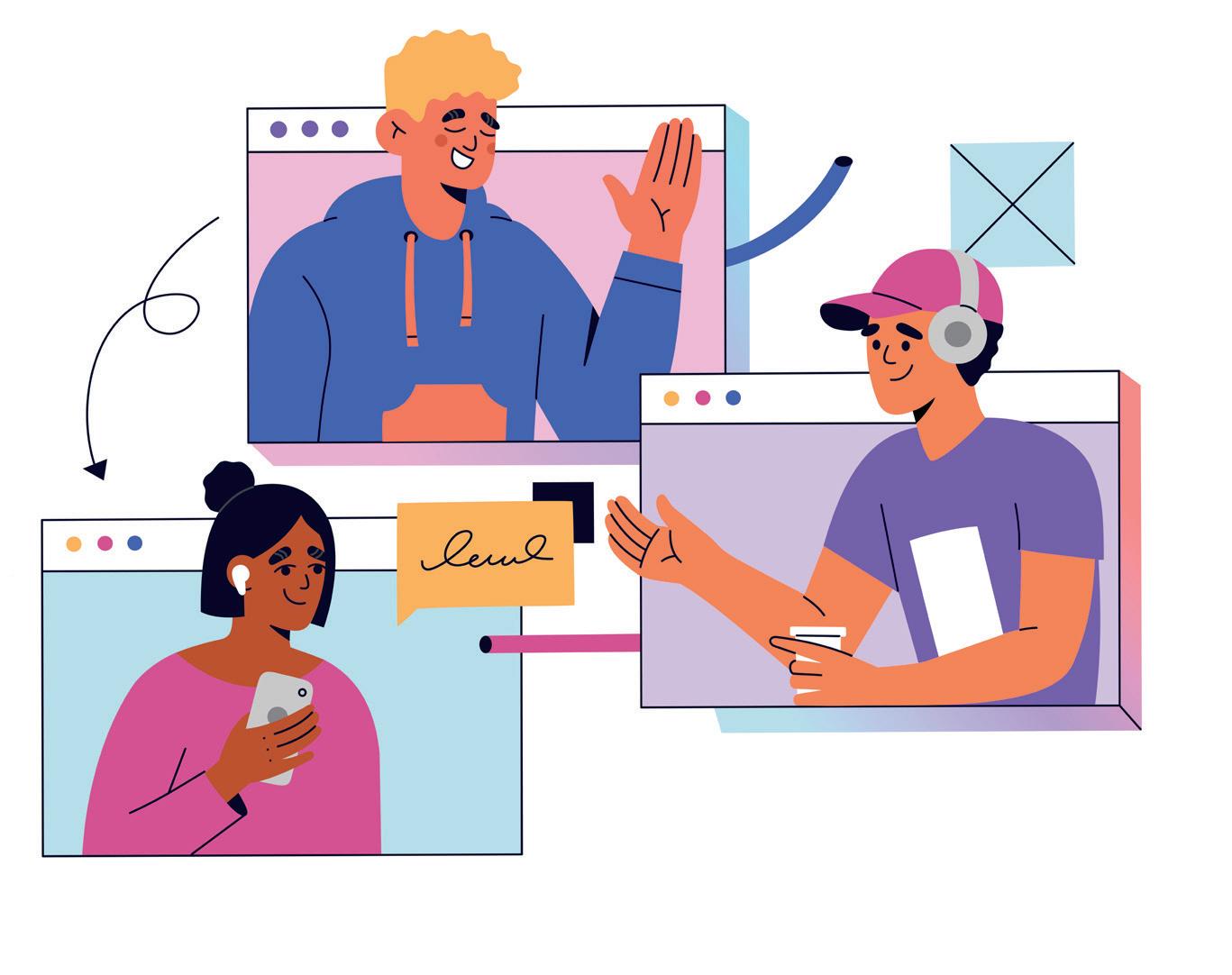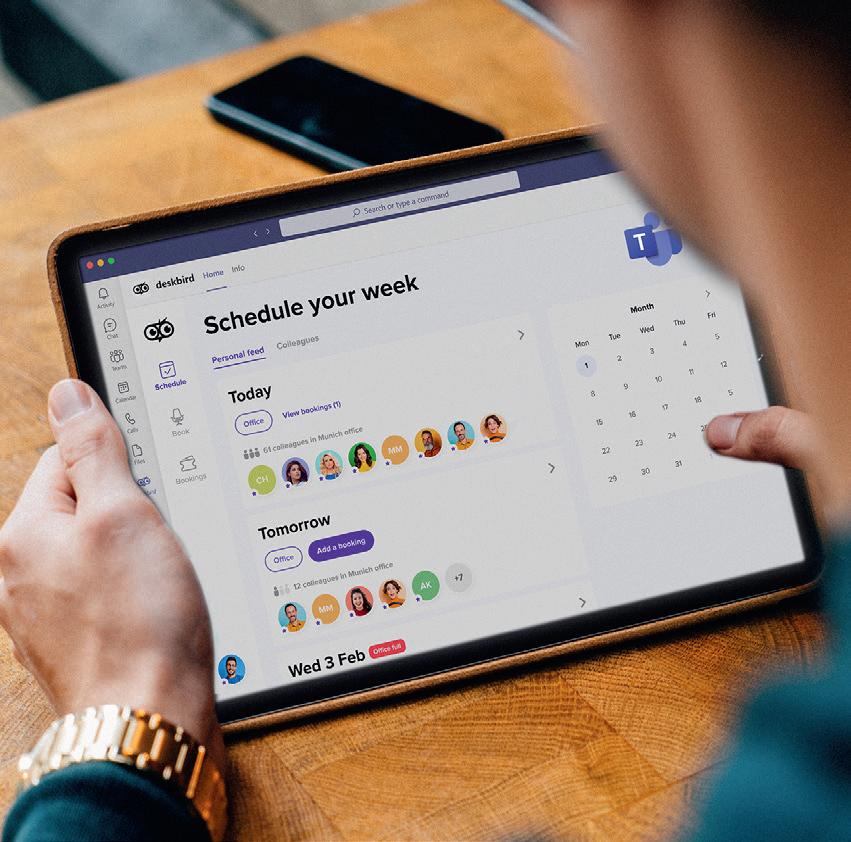

Transfo rm ing the Workplace www.businessandindustry.co.uk Q2 2023 | A promotional supplement distributed on behalf of Mediaplanet, which takes sole responsibility for its content “As office work becomes more dispersed, and hybrid working the norm, offices are becoming hubs.” Richard Kauntze, Chief Executive, The British Council for Offices Page 08 “A resilient workforce has no employee burnout, low staff turnover and absenteeism rates.” Dawn Lewis,
Reward & Employee Benefits Association (REBA) Page 10
Editor,
New tech is bringing remote workers together more effectively than ever before. Employers need to embrace this — and fast.

Working from home can be intense. A 2022 Parliamentary Office of Science and Technology report highlighted that workers feel obliged to work harder and for longer when at home.
Enabling remote and asynchronous work
Our growing culture of remote working has left a physical and expectational disconnect between employees and their employers. This is a lose-lose situation; if staff are demotivated and unclear on what’s expected of them, they’re more likely to be unproductive and unhappy. We can combat this by using technology to bring teams together and allow them to communicate effectively.
However, according to a survey of 3,000 office workers from Sony Professional Displays and Solutions, 58% don’t believe their company has the technology needed to facilitate flexible, asynchronous work. Employers need to embrace asynchronous and provide the technology needed to make it work.
Bringing the best of the office home
Feeling disconnected from day-to-day office life can be difficult for remote workers, so bringing some office culture home while maintaining healthy boundaries and flexibility is essential. Making remote workers at hybrid events feel as if they’re ‘in the room’ is an important part of this.
High-quality audio and video for calls and events can engage employees, but this doesn’t have to mean expensive setups with plenty of hardware. The use of ceiling-installed beamforming microphones, pan-tilt-zoom (PTZ) cameras with built-in auto-tracking technology and screen-sharing software can facilitate high-quality production with ease.
It’s also important to make the most of time in the office, using office management systems like TEOS and BRAVIA professional displays. They can help employees in the workplace, such as with engaging presentations, navigating the office and booking meeting rooms. Having these options can make the office a more collaborative, productive environment.
According to Sony’s survey, 61% of workers believe that asynchronous working can promote a healthier work-life balance. This number is only growing and can’t be ignored if businesses want to attract the best talent. With technology constantly changing, employers have to find more ways to support flexible work.
Labour shortages are here to stay: how can flexible working help?
With more people taking early retirement and altered migration patterns since Brexit, the UK is facing a long-term shortage of workers. How can flexible working help?
BY Alexandra Hall-Chen Principal Policy Advisor Institute of Directors

From Elon Musk ordering Twitter employees back to the office to Jacob Rees-Mogg leaving cards reading ‘Sorry you were out when I visited’ on civil servants’ desks, the media seems awash with examples of bosses pushing employees to get back to the office. But what is really happening?
Flexible working is here to stay in the UK Institute of Directors (IoD) research, last year, found that 8 in 10 business leaders plan to offer their employees some form of remote working. For some, this consists of one day per week working remotely. For many, it takes the form of giving staff full choice over where they work (27%) or the organisation operating via fulltime remote working (13%).
The key driver behind this is simple: organisations that fail to offer flexible working will struggle to recruit and retain talented employees. Flexible working represents a way for employers to attract groups traditionally on the edge of the labour market. Research from Working Families, for instance, found that 9 in 10 unemployed parents would be likely to apply for a role that listed flexible options.
can improve their employee value proposition in a competitive labour market.
What does innovation in flexible working look like?
CMG Technologies, a manufacturing company in Suffolk with 35 employees is one example. In 2015, they introduced a four-day week to improve staff wellbeing and retention. It has led to extremely strong staff retention and increased staff motivation and productivity. Their lead times have even shortened as teams optimised manufacturing processes.
Or take Hana Group, a food producer with over 700 employees in the UK. Since the nature of the company’s work means that most staff cannot work remotely, they introduced early morning and later morning shifts. This allows staff to, for instance, drop children off at school before coming to work. They also introduced an app which displays employees’ working hours and allows them to swap shifts without requiring permission from managers.
WRITTEN BY Adam Dover Trade & Segment Marketing Manager, Sony Professional Displays & Solutions


By thinking innovatively about less common forms of flexible working — such as compressed hours, flexible hours and job shares — employers
These initiatives are dispelling the myth that flexible working only benefits office workers. More employers must think similarly about how they can offer flexibility to attract and retain workforces to help them thrive.
02 MEDIAPLANET A PROMOTIONAL SUPPLEMENT DISTRIBUTED ON BEHALF OF MEDIAPLANET, WHICH TAKES SOLE RESPONSIBILITY FOR ITS CONTENTS READ MORE AT BUSINESSANDINDUSTRY.CO.UK
@BusinessandindustryUK @MediaplanetUK Please recycle
Project Manager: Tilly Dodwell matilda.dodwell@mediaplanet.com Associate Project Manager: Jack Adamson Business Development Manager: Josie Mason Managing Director: Alex Williams Head of Business Development: Ellie McGregor | Head of Print & Design: Thomas Kent Designer: Aimee Rayment Content Editor: Angelica Hackett O’Toole | Head of Digital Operations: Harvey O’Donnell Paid Media Strategist: Jonni Asfaha Social & Web Editor: Henry Phillips Digital Assistant: Carolina Galbraith Duarte | All images supplied by Gettyimages, unless otherwise specified | Contact information: uk.info@mediaplanet.com or +44 (0) 203 642 0737
WRITTEN
Remote workers should be able to connect and engage whenever they need
Paid for by Sony
Organisations which fail to o er flexible working will struggle to recruit and retain talented employees.
To read Sony’s latest research on The Future of Work and find out more about its corporate solutions, visit pro.sony
How companies can switch to the ‘everywhere workforce’ and unlock global talent
The way we live, work and do business has rapidly changed in the last several years. Technological advances encouraged a shift to digital-first economies that require adaptive teams.
HR technology with global talent reach Enter global growth technology — a new category within HR technology that provides everything a company needs for global growth. The AI-based products in the category provide rich insights and global expertise, remove the friction for global expansion and ensure compliant employee lifecycle management.
G-P, the pioneer and leader of the employer of record industry, is driving innovation in the global growth technology category with significant investments in new products that help companies find, hire and manage talent worldwide.
“Global growth technology is an evolution of EOR sparked by the demands and opportunities of the ‘everywhere workforce.’ McKinsey recently estimated this market to be worth well over $50 billion,” says their Chief Product and Strategy Officer, Nat Natarajan.
“This new category has the ability to catapult businesses to success by providing AI-based products that address everything a company needs for global growth and expansion,” he adds.
Natarajan’s company is enabling global growth by taking EOR to a new level with a first-of-its-kind, fully customisable global employment suite that provides everything a company needs for global growth — from hiring tools, HR and legal document templates to insights on hiring markets — allowing companies to build and manage teams in 180+ countries. It enables turn-key global expansion, helping businesses of all sizes be more nimble in breaking into new markets quickly and compliantly.
The future of work is flexible G-P believes companies need flexibility and tools that enable them to go global, their way. Natarajan notes that the way people do business will continue to change substantially as global growth technology offers new ways for employers to take advantage of the ‘everywhere workforce.’
“There isn’t one right way to do business or build a global team,” he admits. “However, with the right global growth technology and partner, companies can make global growth part of their long-term business strategy.”
Natarajan predicts that, over the next three years, we will see the global growth technology category expand and further dominate the broader EOR industry as businesses embrace this ability to build diverse teams — from anywhere on the planet.


Access to a workforce without borders
“Our vision for the future of global hiring taps into the fullest human potential,” Natarajan continues. “In this future, employers build teams without borders and leverage their unique insights and experiences, resulting in teamwork made possible for everyone, everywhere.”
Modern work isn’t just about where your business lives today. It’s about where opportunities can take you tomorrow.
A PROMOTIONAL SUPPLEMENT DISTRIBUTED ON BEHALF OF MEDIAPLANET, WHICH TAKES SOLE RESPONSIBILITY FOR ITS CONTENTS READ MORE AT BUSINESSANDINDUSTRY.CO.UK 03 MEDIAPLANET Find out more at g-p.com/g-pmeridian-suite
The Employer of Record (EOR) industry is transforming international business and enabling organisations to unlock their business potential through the evolution of global growth technology.
INTERVIEW WITH Nat (Rajesh) Natarajan, Chief Product & Strategy Offi cer, G-P
Technological advances encouraged a shift to digital-first economies that require adaptive teams.
WRITTEN BY Mark Nicholls
Our vision for the future of global hiring taps into the fullest human potential.
Paid for by G-P
Image provided by G-P
How to ensure the green transition works for people, places and firms
Place-based actions are needed to deliver the green transition and leave no workers or places behind.
Climate action policies are transforming the world of work. Around 18% of workers are now doing green jobs in OECD regions. Across all sectors, a shift towards more sustainable and climate-friendly processes and production is affecting workers and firms alike. However, not all are reaping the rewards.
Inequalities to address in green transition
A recent report shows that more than two-thirds of green jobs (71%) are held by men and less than one-third (29%) by women. Large firms account for 31% of green jobs compared to 25% of other jobs, and large regional gaps exist between lagging and leading regions. Capital regions have the largest share of green jobs in 75% of OECD countries. Policy should drive the green transition, while addressing its uneven impacts — including its implications for different places.

Growing demand for green talent
Firms are suffering from labour and skills shortages, in particular for green jobs. In Europe, more than 80% of companies face green skills shortages. A lack of workers with relevant skills could hold back the green transition because it could impede the scaling up of green sectors and the development of new technology, including electric vehicle production, semiconductors and hydrogen solutions. Moreover, forecasts predict a massive growth in the demand for green talent as local communities and sectors such as energy, manufacturing and automotive transform.
WRITTEN BY Dr Lukas Kleine-Rueschkamp Coordinator – Local Labour Market Analysis, OECD Centre for Entrepreneurship, SMEs, Regions and Cities

Boosting local green skills
Governments need to rapidly redesign local skills systems to reach more people and places. Only 40% of adults participate in job-related training across the OECD, despite rapidly changing responsibilities due to the green and digital transitions.
Workers who would benefit the most are often much less likely to retrain or upskill. Workers in polluting jobs (ie. those that are concentrated in the most emission-intensive sectors) that might disappear or face significant change are 50% less likely to participate in adult learning than workers in green jobs.
There must be more access for vulnerable groups and incentives for employers and employees to offer and engage in adult learning. Training curricula should reflect changing job requirements and incorporate green skills.
Supporting career transitions and regional transformation
Encouraging workers out of polluting jobs or into other sectors is a priority. This could yield a triple dividend of job security for workers — addressing green skills shortages and avoiding a greater green gap between people, places and firms.
04 MEDIAPLANET A PROMOTIONAL SUPPLEMENT DISTRIBUTED ON BEHALF OF MEDIAPLANET, WHICH TAKES SOLE RESPONSIBILITY FOR ITS CONTENTS READ MORE AT BUSINESSANDINDUSTRY.CO.UK
In Europe, more than 80% of companies face green skills shortages.
to a hybrid working model

If powered with the right easy-to-use technology, hybrid working can help businesses streamline their operations, save money and improve staff productivity.

The Covid-19 pandemic wasn’t the catalyst for the hybrid working phenomenon, admits Ivan Cossu, Co-founder and CEO of deskbird, a hybrid office management app. But it certainly accelerated it. “Hybrid working was in evidence pre-pandemic,” he says. “But it never felt as though many companies were making a deliberate choice to implement it. That’s changed now. Hybrid working has had a domino effect across the work landscape.”
Big benefits of hybrid working Employers and employees have felt the benefits of hybrid working over the last three years. For employees, spending two or three days in the office is a way to improve work-life
balance and cut down on commuting. “Hybrid working can save one year of commuting time across a person’s lifetime,” reveals Cossu. Employers, meanwhile, have discovered that hybrid can increase productivity and improve morale. “Instead of staff having to come to the office because it’s ‘the rule,’ they can often accomplish more at home where there are fewer distractions and go to the office only when it’s necessary or when they want to,” says Cossu. “As a leader, I measure my staff on output. Being forced to come to the office won’t make them more productive.”
Technology for better management of hybrid working Hybrid working can also save on office space costs. “It cuts down on ancillary
costs, such as heating and facility management,” explains Cossu. “And it gives firms access to a wider talent pool because staff aren’t tied to the office on a day-to-day basis.”

Effective management of hybrid offices can be a challenge, which is why using the right technology is an important component of this new working world. “Any company that wants to embrace hybrid working should have their entire IT spec and processes fully digitised and in the cloud,” says Cossu.
Hybrid working can save one year of commuting time across a person’s lifetime.
The best hybrid management technology should be easy to integrate with other tools and have a user-friendly interface to encourage better organisation among staff. “For example, employees can use apps like ours to book parking spaces, desks, meeting rooms and track office occupancy,” adds Cossu.
“If they want to brainstorm with specific colleagues, they can use it to see who will be in the office on a particular day and receive a notification when they arrive. Technology like this is the way forward because it helps everyone deal with a new working reality.”

A PROMOTIONAL SUPPLEMENT DISTRIBUTED ON BEHALF OF MEDIAPLANET, WHICH TAKES SOLE RESPONSIBILITY FOR ITS CONTENTS READ MORE AT BUSINESSANDINDUSTRY.CO.UK 05 MEDIAPLANET
INTERVIEW WITH Ivan Cossu
Co-founder and CEO, deskbird
WRITTEN BY Tony Greenway
Find out more at deskbird.com/try-it Paid for by deskbird
Why more advanced companies are moving
Many employers have moved to a hybrid model of working whereby sta split their time between the o ce and their homes.
~Andrew Berrie, Head of Workplace Wellbeing, Mind
Working nine-to-five at a desk in a crowded office with little natural light and nowhere to quietly focus on work or chat with your team is becoming a thing of the past.
Employee wellbeing is now top of the agenda as more forward-thinking companies seek to provide spaces where their people can focus, collaborate, be inspired and recharge — and where teams can be brought together and feel empowered to do their work.
Office design that encourages productivity








The Office Group, which has more than 70 buildings and some 30,000 members, provides clients with an array of work-style spaces crafted to meet all of these criteria, allowing companies to be ever more flexible while helping to boost their bottom lines.
According to their CEO Enrico Sanna, there is strong evidence to support the idea of putting employee wellbeing at the forefront of bosses’ minds. He says: “Prioritising wellbeing empowers productivity and is key to a team feeling valued and trusted.

“In a recent customer survey, we saw 98% of our members agree that an enjoyable workspace can make employees happier. Also, 91% agreed that badly designed workspaces can negatively impact an employee’s wellbeing.”
The need to move out of traditional offices Changes to office style and use were beginning before Covid-19 struck, sending everyone to work from home. However, the pandemic is undoubtedly responsible for speeding up the transformation process.
“It showed just how much in need of change the traditional model of working five days a week, at a desk, in an office with zero flexibility was,” explains Sanna. “That desire to reimagine the workplace experiences and to
empower people to work in a new, flexible way has been at the heart of our business from day one.
“Our clients were embracing a new approach to work even before Covid-19; and now, flexible workspaces are predicted to reach more than 20% of the market by 2030.”
A space to recharge and collaborate
The Group’s latest, and largest to date, ‘workspace experience’ is Chancery House situated in Holborn, London. It has been wholly designed with wellbeing at its core. As well as considering air quality, light and acoustics within the design, more than a quarter of the building is dedicated to wellness. This includes an on-site gym, café, library and plenty of outdoor space. There is an abundance of natural light and an outdoors/indoors feel, allowing people to get out easily for a breath of fresh air.
Members will enjoy a first-of-its-kind office space where they are enabled to create and connect, as well as recharge and relax. Every detail has been considered in a bid to support productivity. The needs of different working styles are met with a range of workspaces from focus booths to comfortable lounges, plus 17 meeting rooms for collaborative work.
Thinking of new ways to empower employees
Sanna recognises the importance of well-designed workspaces, conducive to employee wellbeing and productivity. He believes workspaces should not just be about property but must be focused on people and the enormous value they can achieve from a collaborative, healthy workplace.
“The office isn’t a commodity, it’s a space where you bring your team together and empower them to do their work, in their way. They need space where they can focus, collaborate, be inspired and recharge to do this successfully,” he concludes.
06 MEDIAPLANET A PROMOTIONAL SUPPLEMENT DISTRIBUTED ON BEHALF OF MEDIAPLANET, WHICH TAKES SOLE RESPONSIBILITY FOR ITS CONTENTS READ MORE AT BUSINESSANDINDUSTRY.CO.UK
Paid for by The Office Group
Prioritising wellbeing empowers productivity and is key to a team feeling valued and trusted.
A transformation in the way people work has been supercharged by the Covid-19 pandemic and resulted in wellbeing placed at the centre of new workspace design.
An office space designed for employees boosts productivity and wellbeing
INTERVIEW
WITH Enrico Sanna CEO, The Offi ce Group
Companies must ensure that their office meets the needs of their people and allows them to be productive, thrive and enjoy coming to work.
Our philosophy is to give people the freedom to do their best work, in their best way. As a team, we have developed a list of alternate work settings for clients that offer ways to reimagine the office to suit their different work styles. We think about the intrinsic design of our spaces and the needs of the people who will use them — not just the physical positioning of walls and task chairs.
I think companies are all looking for the same thing: a place where employees can thrive and have access to amenities and a variety of spaces they can work. They want workspaces that are professional, yet playful. We set ourselves the challenge of keeping it classic and timeless but interesting.

Zones and spaces for various purposes
We are definitely seeing a demand from our members for more open spaces in the buildings to meet, create and collaborate. But collaboration is as much a chance encounter at the coffee machine as a formal ideation session in a dedicated breakout space. Being together in one space that encourages social interaction is key.
Part of this is creating different zones for different purposes, which enhance productivity — be it for ‘quiet’ working time, shared thinking or that essential downtime.














Our buildings include ample phone and focus booths for virtual calls for when you need quiet space to work, as well as larger meeting and project rooms for team working. Alongside that, there are private offices, as well as co-working lounges and breakout spaces.
Creating a functional workspace
High-level storage is an opportunity to dress the space with plants — accents of green can really imbue a sense of calm into an office environment. Elements such as curtains or moveable walls, which allow the function of a space to change quickly to suit different needs, are being used more.
Where people want to foster the social element and reconnect with colleagues, they could create soft seating zones or replace banks of desks with project team tables. There’s a greater need for people to have personal storage as the ‘clean desk policy’ increases in popularity, so room divides with integrated lockers can be introduced to zone areas, too.
Spaces that encourage social interaction
The journey of moving from one place to another gives you time to refocus and is a design consideration in all of our buildings. Our cafes are great for one kind of conversation, and our lounges are good for another.
At our own head office, we are bringing the kitchen and tea points front and centre to the experience, encouraging teams to take time to reconnect, for example.
Design that balances comfort and productivity
There is a big emphasis on ‘resi-mmercial’ design at present, which combines residential and commercial spaces. People want elements they have had in their living room — such as comfortable textiles, warm colour palettes, good heating, lighting and acoustics — at the office. They also want the amenities that are not present at home but are crucial to a good work-life balance: fitness studios, meditation rooms, cafes and outdoor spaces.
Ultimately, great design should be accessible to everyone — now, more than ever. The industry should take note of this and work to bridge the gaps to create an exceptional office environment for all.
A PROMOTIONAL SUPPLEMENT DISTRIBUTED ON BEHALF OF MEDIAPLANET, WHICH TAKES SOLE RESPONSIBILITY FOR ITS CONTENTS READ MORE AT BUSINESSANDINDUSTRY.CO.UK 07 MEDIAPLANET Find out more at theofficegroup. com/work-well
Why comfortable, well-equipped and flexible workplaces put employees to work
INTERVIEW WITH Claire McPoland Design Lead, The Offi ce Group
SPREAD WRITTEN BY Sheree Hanna
How to design future offices that are better for employees and the environment
Our relationship with the office is evolving. Changing working patterns, employee expectations and business needs since the pandemic have led occupiers, building owners and designers to rethink fundamentally what the office of the future could look like.

Healthier offices, happier people
It is the British Council for Offices’ mission to research, develop and communicate best practices in all aspects of the office sector. Accepting the challenges facing the office sector post-pandemic and the accelerated need to respond to climate change, we released an early update to our flagship publication the ‘Guide to Specification’ in 2023.
WRITTEN BY Richard Kauntze Chief Executive, The British Council for Offices

Future offices enable resilience and inspiration
The role of offices is shifting towards something more meaningful and intentional — a place where connection, community, collaboration and learning are concentrated; a workplace to which people choose to commute and which brings out the best in them and their colleagues.

As office work becomes more dispersed, and hybrid working the norm, offices are becoming hubs. They are focused on inspiration, creativity and innovation — all elements vital to our future prosperity. With the role of the office now rightly centred around the workplace experience and social impact, the relationship between building owner and occupier has shifted significantly.
Employers face competition for talent and the need to support the wellbeing of their employees, while simultaneously implementing broader environmental, social and governance (ESG) targets, which are increasingly the key drivers on decisions affecting real estate investment.
The guidance is considered the ‘design bible’ for high-quality offices and advises designers on how to create healthier offices that support changing working patterns while reducing carbon emissions. New this year are more generous space standards and greater design flexibility. The 2023 update will promote the decarbonisation of the office sector and enact change to help the industry deliver on the UK’s net zero by 2050 target.
As we continue to rethink office space, we need to focus on hospitality and human-centric design. This must be aligned with frictionless technology interfaces to help building owners and occupiers monitor the use, carbon performance and employee experience. If we create high-quality offices focused on hospitality, a human-centric approach and sustainability, the UK will be well-equipped to adapt to the ever-changing working environment and drive economic growth and productivity.
08 MEDIAPLANET A PROMOTIONAL SUPPLEMENT DISTRIBUTED ON BEHALF OF MEDIAPLANET, WHICH TAKES SOLE RESPONSIBILITY FOR ITS CONTENTS READ MORE AT BUSINESSANDINDUSTRY.CO.UK
Future offices will not only support a creative and productive work culture and employee wellbeing but also play a vital part in decarbonising our cities.
As we continue to rethink o ce space, we need to focus on hospitality and human-centric design.
WRITTEN BY Tony Greenway
How companies can adapt to the brave new world of hybrid work
The world of work is changing, with employees demanding more flexibility and better office amenities.
Three specialists from real estate firm JLL reveal how the world of work is changing post-pandemic — and how companies can adapt.

Post-Covid-19, what does the working landscape look like?
Guzman de Yarza Blache: Increasingly hybrid but with different patterns globally. In Asia-Pacific, workers go to the office more frequently, but less so in Europe and particularly the US. In the UK, it differs depending on the region and company type. It’s a complex picture — but, generally, people are going to the office less than what was originally expected when companies were planning their hybrid policies.
How does an occupier decide what the ‘best’ office is?
GYB: They should adopt a people-centric approach to real estate. We always tell our customers to listen to what their people say about their office needs and wants. There’s no other way to get it right.
Dan Bayley: The ‘best office’ has been defined by collaboration within the organisation — then designed, delivered and operated properly. Critically, business management must commit to the use of that office.


What types of offices are most resilient?
DB: Service operators offering a flexible lease are attracting companies that don’t want a long-term commitment to real
estate. Office location-wise, the City and West End are doing well in central London. East London, despite improved connectivity, hasn’t recovered so well — although I think it will, in time. Suburban markets and out-of-town business parks are finding the environment tougher.
How are companies adapting to hybrid working?



GYB: Corporates are demanding less — but better — space. They want a smaller footprint but are willing to pay more for a renovated building close to good public transport and with ESG and sustainability credentials. There’s been a shift in office design from the ‘me’ space to the social ‘we’ space. It must be an attractive destination with good amenities, programmes and technology. Workplaces are becoming more complex since they must compete with other places where people can work. It used to be workstations and meeting rooms. Now, it’s a whole ecosystem of environments enabled by technology.
How can companies find the right talent?


Kelly Hamer: The dynamic is changing. Companies should focus on building relationships with educational institutions (universities, schools and colleges) to continually attract the best and most diverse talent pool. They must offer flexibility. A UK&I project we carried out found that around 75% of applicants didn’t initially ask about salaries; they asked about flexibility. That’s a new reality — especially with the cost of living.

Is your office ready for the future world of work?
The purpose of the workplace has changed, make the right decisions for your business and its people to thrive.
A PROMOTIONAL SUPPLEMENT DISTRIBUTED ON BEHALF OF MEDIAPLANET, WHICH TAKES SOLE RESPONSIBILITY FOR ITS CONTENTS READ MORE AT BUSINESSANDINDUSTRY.CO.UK 09 MEDIAPLANET
Learn more Find out more at jll.co.uk Paid for by JLL
INTERVIEW WITH Kelly Hamer
Global Location Strategy Lead, JLL
INTERVIEW WITH Dan Bayley Director, Tenant Representation London, JLL
INTERVIEW WITH Guzman de Yarza Blache
Global Head of Workplace Strategy, JLL
WRITTEN BY Dawn Lewis Editor, Reward & Employee Benefi ts Association (REBA)

Business resilience may suffer if employees are left out of the picture
With pressures from investors, governments, customers and employees, transformation in the workplace has never been more intense. With so much change facing organisations, the need for business resilience is critical.
Findings from the Reward & Employee Benefits Association (REBA) research ‘Evolving EVP: meeting business and workforce change’, published in partnership with Mercer Marsh Benefits in June 2023, highlight that people resilience is central to building business resilience.
Reasons business resilience is crucial
Changing ways of working; differing skills requirements; technology advances and demand for workplaces to offer a sense of purpose; while simultaneously protecting and enhancing employees’ wellbeing are all important to developing and supporting a resilient workforce that is agile and adaptable to meet future business needs.
What makes a workforce resilient?
A resilient workforce has no employee burnout, low staff turnover and absenteeism rates. It has good ongoing skills development and high productivity and engagement levels. Yet, REBA’s research indicates a gap between the nearly threequarters (73%) of HR leaders who see resilience as a ‘business challenge’ and the 60% who believe creating a resilient and/or sustainable workforce is a key ‘HR challenge.’ If employers fail to recognise the need to transform their workforce, then overall business resilience may suffer.
For HR, this means adapting to meet employee and candidate expectations, which are continuing to transform.
Why hybrid working






tool to improve employee mental health
Thousands of people are now working from home, either some or all of the time. But how is hybrid working impacting our mental health?

Employers anticipate an increase in demand for: clear career progression pathways; culture and/or support which avoids burnout; more/enhanced benefits; flexibility on time/location of work; clear links between work and corporate purpose.
Where progress is being made and where it is needed
Since the pandemic, many office-based workplaces have changed in ways we wouldn’t have thought possible. There are some major benefits to hybrid working, the most significant of which is flexibility. Through that flexibility, people can achieve a greater level of work-life balance by working in a way that best supports them to thrive at work.
It also allows a greater sense of control, which can help our mental health and wellbeing. Being able to manage your time effectively — for both in-work and outside-work priorities — can help ease worries and stress. We have found that this sort of benefit means that employees report improved mental health and wellbeing.
What are the drawbacks of hybrid working?
The greatest challenge in implementing any hybrid working policy is based on individual and personal preferences. Everyone does their best work in different environments. Everyone has a different flexibility requirement or preference — as well as various personal circumstances. For example, younger people are less likely to have enough space to work at home, particularly if they live in shared accommodation. Having an office to work from can ease that stress and make their lives much easier.

at enhancing the
The good news is that employers are already making headway in many of these areas. REBA’s research shows progress being made in wellbeing support, the offering of health and risk benefits and greater provisions for employees’ families. However, fewer employers felt benefits aligned with changing demographics of the workforce and that benefits linked to skills development were highly effective at enhancing the employee offering.
The mismatch between employee expectations around career progression pathways and the employers’ approach to benefits that support skills development needs to be addressed. If employers are unable to attract and retain the talent necessary — as well as upskill their existing workforce — it will pose a risk both to individual employees and the resilience of the business.
Only through transforming the employee offering can employers develop a workforce that is capable of steering a business into a sustainable and resilient future.
Many employees working remotely are anxious that they might have reduced opportunities to network with senior members of staff or opportunities to develop, for example by volunteering for stretch projects. This concern is supported by research undertaken by the Work Foundation and CMI which found 23% thought access to stretch projects would decrease through hybrid working. If access to such opportunities is lower for remote workers than for those working on-site, this could potentially create a two-tier workplace.
Employers should find out what works for their employees
Many employers have moved to a hybrid model of working whereby staff split their time between the office and their homes. However, this is another routine change which requires employers to carefully implement, regularly communicate and listen to staff feedback.
Regardless of the working model, employers and line managers need to set clear expectations for their employees, communicate new ways of working with clarity and ensure that employee support remains available and easily accessible. All employers should offer flexibility to their staff so that they can fit existing commitments around their work — which can keep them happy and well.
10 MEDIAPLANET A PROMOTIONAL SUPPLEMENT DISTRIBUTED ON BEHALF OF MEDIAPLANET, WHICH TAKES SOLE RESPONSIBILITY FOR ITS CONTENTS READ MORE AT BUSINESSANDINDUSTRY.CO.UK
is a great
WRITTEN BY Andrew Berrie Head of Workplace Wellbeing, Mind
If employers are unable to attract and retain the talent necessary — as well as upskill their existing workforce — it will pose a risk both to individual employees and the resilience of the business.
A holistic approach to reward is highly aligned to culture









A new generation expects enhanced reward packages above traditional benefits as they seek a more flexible and supportive working environment.
More than ever, the use of employee rewards in a changing landscape is crucial to recruiting and retaining talent. According to Isha Smith, this should go beyond traditional aspects and connect with the employer’s unique value proposition. Smith oversees total rewards, learning and development (L&D) and people analytics at music entertainment company SoundCloud in the UK, Germany and the US.


Culture is key to meaningful rewards As Director of Total Rewards, Smith believes that rewards aligned with company culture and values, beyond the notion of ‘market competitive’ offering, deliver a more authentic experience.


“For us, this means defining the ‘SoundCloud Way’ — aligned to employee demographic, our values






















and DEI commitment — catering to talent across dual worlds of tech and music. We strive to view everything we do in the employee experience journey through this lens.”





Rewards for development









That ‘holistic approach’ encompasses performance recognition, work–life balance, personal and professional growth and comprehensive wellbeing benefits, with equal access for everyone. “Increasingly, we are looking at learning and development as a big part of our reward proposition: it reflects our collaborative and agile environment,” she says. The company’s L&D benefit includes days and financial support dedicated to learning opportunities. “We are committed to building a culture that drives individual growth, creating formal and informal growth opportunities,” Smith adds.

Going beyond with inclusive benefits Smith underlines the importance of supportive and inclusive benefits. More recently, to complement its generous family leave offering, the company has introduced familyforming and fertility benefits. This includes support in navigating fertility care, access to fertility treatments and family-building support such as adoption and surrogacy, along with financial assistance. “Our mission is to make sure people feel supported — we truly believe that SoundCloud is for everyone.”
In contrast with the increasing number of businesses adopting formal hybrid working/return to office policies, the company is holding onto its ‘no mandatory office days’ stance. Instead, the company’s Workplace team is bringing its ‘Connect First’ approach to life around cultural moments of celebration. “It is a mutual relationship — we want to adapt to the changing needs of our employees; and this ties into that holistic view of rewards, employee experience and DEI,” she says.













Smith believes the company’s approach to rewards helped it better weather challenges — not only external macro challenges but also its own transformation — but she emphasises the need to share information about company goals and priorities to drive engagement.

A PROMOTIONAL SUPPLEMENT DISTRIBUTED ON BEHALF OF MEDIAPLANET, WHICH TAKES SOLE RESPONSIBILITY FOR ITS CONTENTS READ MORE AT BUSINESSANDINDUSTRY.CO.UK 11 MEDIAPLANET
INTERVIEW WITH Isha Smith Director, Total Rewards, SoundCloud
WRITTEN BY Mark Nicholls
Paid for by SoundCloud
The greatest challenge in implementing any hybrid working policy is based on individual and personal preferences.
~Andrew Berrie, Head of Workplace Wellbeing, Mind

12 MEDIAPLANET A PROMOTIONAL SUPPLEMENT DISTRIBUTED ON BEHALF OF MEDIAPLANET, WHICH TAKES SOLE RESPONSIBILITY FOR ITS CONTENTS READ MORE AT BUSINESSANDINDUSTRY.CO.UK
If employers fail to recognise the need to transform their workforce, then overall business resilience may suffer.
~Dawn Lewis, Editor, Reward & Employee Benefits Association (REBA)

































































































